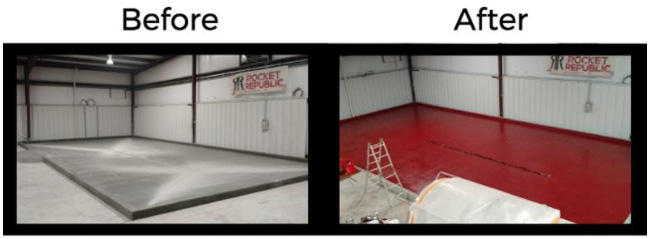Insure the floor is as dry as possible without any puddles of water present. If there is excess water on the substrate, take up excess with a suitable vacuum and wait until dry (as possible) condition exists. Then, after the material is thoroughly mixed, pour the material onto the substrate.
Either use a trowel to push out and level the material evenly or spread with a gauge rake set to the 1/8″ height with cam pins followed by an air release spiked roller tool. (Note cam pins will wear down from dragging on the floor and need replacing as they wear otherwise your floor will end up too thin. Check gauge rake pins at regular intervals and replace or rotate as necessary) Please note that the product has a limited 15-20 minute working time, so best to have helpers assisting doing the mixing and ‘feeding’ the application personnel. If not topcoating, apply nonskid aggregate by hand onto the wet surface to achieve the desired level of texture. The surface could have an uneven texture, color streaks or color differences and an orange peel look which is normal prior to topcoating. Maintain temperatures between 50-90 degree F.
Do not apply to cracked or unsound concrete. Do not feather edge. If product needs a ‘termination point’, score the floor first with the standard (previously described) 1/8″ wide by 1/8″ deep groove into the floor. Tape the outer edge of the groove and remove the tape prior to product fully curing for a clean edge as once cured the tape will be very difficult to remove.
6) TOPCOATING: Wait 24 hours to topcoat. Mix topcoat A & B together fully with mechanical mixer. Mix evenly and thoroughly moving mixer up/down and all along the bottom of the pail to avoid any unmixed material from getting on the floor. Pour on the floor and roll out. While wet, apply nonskid additive by hand broadcasting onto surface. Backroll aggregate into the topcoat to achieve the desired texture and surface finish.
7) CLEANUP: For cleaning any application, equipment, water can be used. The urethane component container is best cleaned with a suitable solvent such as Xylene. Refer to individual product instructions.
8) FLOOR CLEANING: Caution! Some cleaners may affect the color of the floor installed. Test each cleaner in a small area, utilizing your cleaning technique. If no ill effects are noted, you can continue to clean with the product and process tested.

